2016 MITSUBISHI OUTLANDER SPORT charging
[x] Cancel search: chargingPage 9 of 398
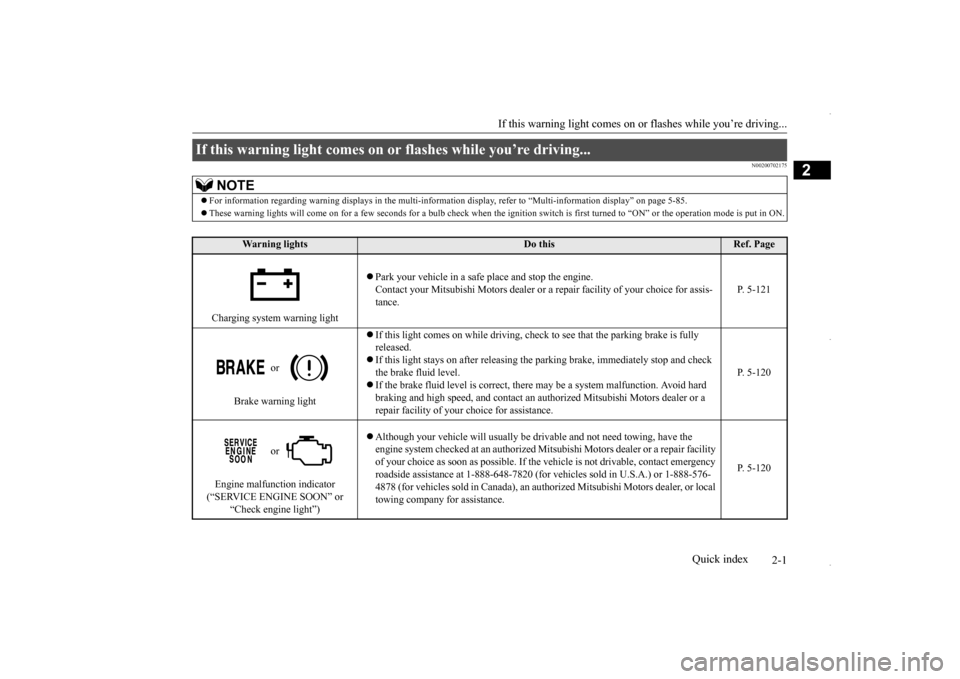
2-1
2
If this warning light comes on or
flashes while you’re driving...
Quick index
N00200702175
If this warning light comes on or flashes while you’re driving...
NOTE
For information regarding warning displays in the multi-informat
ion display, refer to “Multi-information display” on page 5-85.
These warning lights will come on for a few seconds for a bulb check
when the ignition switch is first turned to “ON” or the op
eration mode is put in ON.
Wa r n i n g l i g h t s
Do this
Ref. Page
Charging system warning light
Park your vehicle in a safe place and stop the engine. Contact your Mitsubishi Motors dealer or
a repair facility of your choice for assis-
tance.
P. 5-121
or
Brake warning light
If this light comes on while driving, check to see that the parking brake is fully released. If this light stays on after releasing the parking brake, immediately stop and check the brake fluid level. If the brake fluid level is correct, there may be a system malfunction. Avoid hard braking and high speed, and contact an aut
horized Mitsubishi Mo
tors dealer or a
repair facility of your choice for assistance.
P. 5-120
or
Engine malfunction indicator (“SERVICE ENGINE SOON” or
“Check engine light”)
Although your vehicle will usually be drivable and not need towing, have the engine system checked at an authorized Mits
ubishi Motors dealer or a repair facility
of your choice as soon as possible. If the
vehicle is not drivable, contact emergency
roadside assistance at 1-888-648-7820 (for ve
hicles sold in U.S.A.) or 1-888-576-
4878 (for vehicles sold in Canada), an auth
orized Mitsubishi Moto
rs dealer, or local
towing company for assistance.
P. 5-120
BK0229600US.bo
ok 1 ページ 2015年10月1日 木曜日 午後2時29分
Page 168 of 398
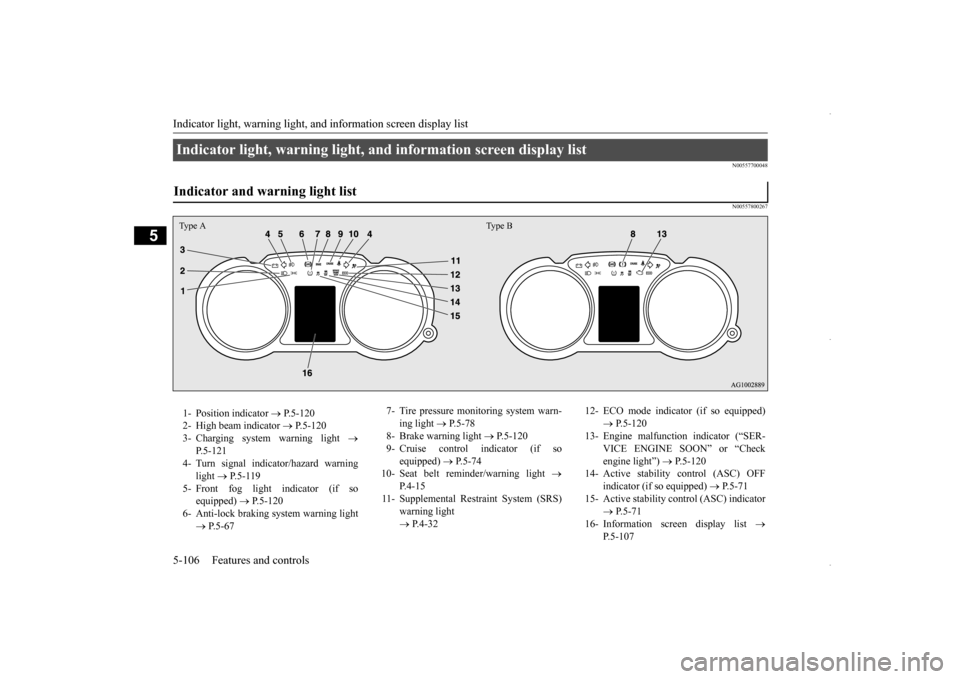
Indicator light, warning light, an
d information screen display list
5-106 Features and controls
5
N00557700048 N00557800267
Indicator light, warning light, and information screen display list Indicator and warning light list Type A Type B1- Position indicator
P.5-120
2- High beam indicator
P.5-120
3- Charging system warning light
P.5-121
4- Turn signal indicator/hazard warning
light
P.5-119
5- Front fog light indicator (if so
equipped)
P.5-120
6- Anti-lock braking system warning light
P.5-67
7- Tire pressure monitoring system warn-
ing light
P.5-78
8- Brake warning light
P.5-120
9- Cruise control indicator (if so
equipped)
P.5-74
10- Seat belt reminder/warning light
P. 4 - 1 5
11- Supplemental Restraint System (SRS)
warning light P.4-32
12- ECO mode indicator (if so equipped)
P.5-120
13- Engine malfunction indicator (“SER-
VICE ENGINE SOON” or “Check engine light”)
P.5-120
14- Active stability control (ASC) OFF
indicator (if so equipped)
P.5-71
15- Active stability control (ASC) indicator
P.5-71
16- Information screen display list
P.5-107
BK0229600US.book
106 ページ 2015年10月1日 木曜日 午後2時29分
Page 177 of 398
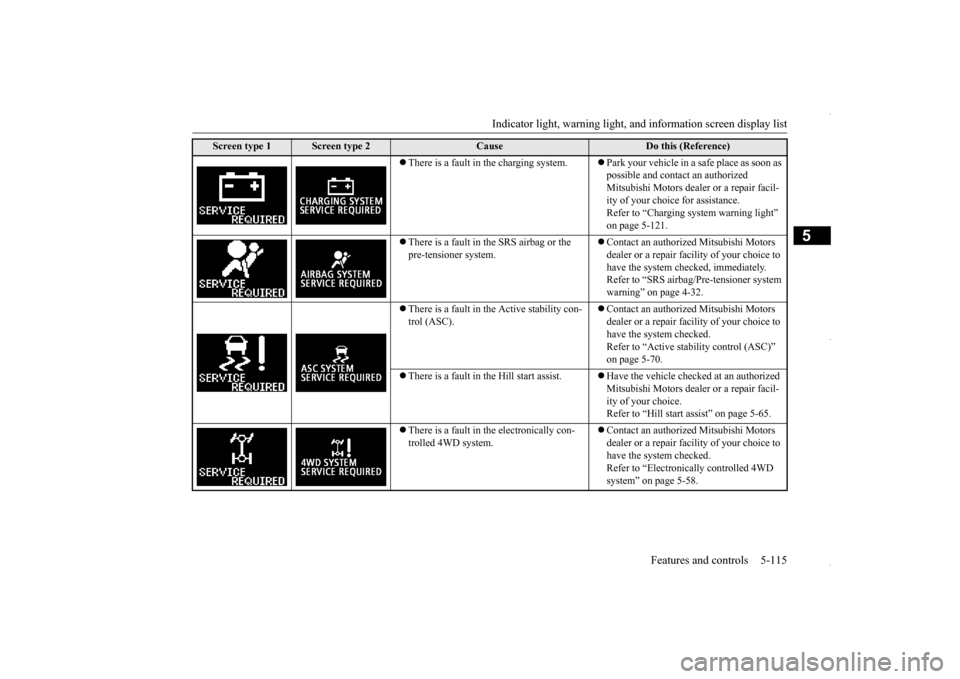
Indicator light, warning light, an
d information screen display list Features and controls 5-115
5
There is a fault in the charging system.
Park your vehicle in a safe place as soon as possible and contact an authorized Mitsubishi Motors dealer or a repair facil-ity of your choice for assistance. Refer to “Charging system warning light” on page 5-121.
There is a fault in the SRS airbag or the pre-tensioner system.
Contact an authorized Mitsubishi Motors dealer or a repair facility of your choice to have the system checked, immediately. Refer to “SRS airbag/Pre-tensioner system warning” on page 4-32.
There is a fault in the Active stability con- trol (ASC).
Contact an authorized Mitsubishi Motors dealer or a repair facility of your choice to have the system checked.Refer to “Active stability control (ASC)” on page 5-70.
There is a fault in the Hill start assist.
Have the vehicle checked at an authorized Mitsubishi Motors deal
er or a repair facil-
ity of your choice. Refer to “Hill start assist” on page 5-65.
There is a fault in the electronically con- trolled 4WD system.
Contact an authorized Mitsubishi Motors dealer or a repair facility of your choice to have the system checked. Refer to “Electronically controlled 4WD system” on page 5-58.
Screen type 1
Screen type 2
Cause
Do this (Reference)
BK0229600US.book
115 ページ 2015年10月1日 木曜日 午後2時29分
Page 183 of 398
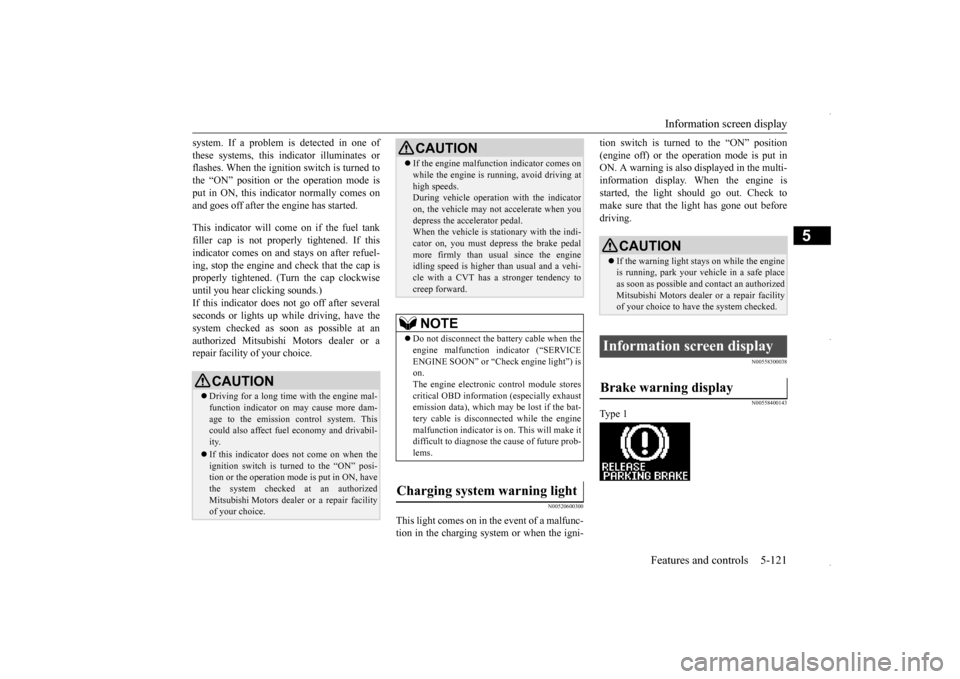
Information screen display
Features and controls 5-121
5
system. If a problem is detected in one of these systems, this indicator illuminates or flashes. When the igniti
on switch is turned to
the “ON” position or the operation mode isput in ON, this indicator normally comes on and goes off after the engine has started. This indicator will come on if the fuel tank filler cap is not properly tightened. If thisindicator comes on and stays on after refuel- ing, stop the engine and check that the cap is properly tightened. (Turn the cap clockwiseuntil you hear clicking sounds.)If this indicator does not go off after several seconds or lights up while driving, have the system checked as soon as possible at anauthorized Mitsubishi Motors dealer or a repair facility of your choice.
N00520600300
This light comes on in the event of a malfunc-tion in the charging system or when the igni-
tion switch is turned to the “ON” position (engine off) or the operation mode is put in ON. A warning is also displayed in the multi- information display. When the engine isstarted, the light should go out. Check to make sure that the light has gone out before driving.
N00558300038 N00558400143
Type 1
CAUTION Driving for a long time with the engine mal- function indicator on may cause more dam-age to the emission control system. This could also affect fuel economy and drivabil- ity. If this indicator does not come on when the ignition switch is turned to the “ON” posi- tion or the operation mode is put in ON, have the system checked at an authorizedMitsubishi Motors dealer or a repair facility of your choice.
If the engine malfunction indicator comes on while the engine is running, avoid driving at high speeds. During vehicle operation with the indicator on, the vehicle may not accelerate when youdepress the accelerator pedal. When the vehicle is stationary with the indi- cator on, you must depress the brake pedalmore firmly than usual since the engine idling speed is higher than usual and a vehi- cle with a CVT has a stronger tendency tocreep forward.NOTE
Do not disconnect the battery cable when the engine malfunction indicator (“SERVICE ENGINE SOON” or “Check engine light”) ison. The engine electronic control module stores critical OBD information (especially exhaustemission data), which may be lost if the bat- tery cable is disconnected while the engine malfunction indicator is on. This will make itdifficult to diagnose the cause of future prob- lems.
Charging system warning light
CAUTION
CAUTION If the warning light stays on while the engine is running, park your vehicle in a safe placeas soon as possible and contact an authorized Mitsubishi Motors dealer or a repair facility of your choice to have the system checked.
Information screen display Brake warning display
BK0229600US.book
121 ページ 2015年10月1日 木曜日 午後2時29分
Page 184 of 398

Information screen display 5-122 Features and controls
5
Ty p e 2 This warning is displayed if the vehicle is being driven with the parking brake still applied. The warning light in the instrumentcluster only comes on when the parking brake is applied. Ty p e 1 Ty p e 2
When the ignition switch is turned to the “ON” position or the operation mode is put in ON, if the brake fluid is low, this warning is displayed.The warning light in the instrument cluster also illuminates.
N00558600103
Ty p e 1 Ty p e 2 If there is a fault in the charging system, the warning display warning is displayed on theinformation screen in the multi-information display. The warning light in the instrument cluster also illuminates.
CAUTION If a vehicle is driven without releasing the parking brake, the brakes will overheat,resulting in ineffective braking and possible brake failure. If this warning is displayed, release the park- ing brake.
CAUTION If this warning stays on and does not go out while driving, there is a danger of ineffective braking. If this happens, park the vehicle in a safe place, and contact an authorizedMitsubishi Motors dealer or a repair facility of your choice. If the brake warning display, brake warning light, and the Anti-lock braking system warning light are illuminated at the sametime, the braking force distribution function will not operate, so the vehicle may be desta- bilized during sudden braking. Avoid suddenbraking and high-speed driving. Park the vehicle in a safe place, and contact an autho- rized Mitsubishi Motors dealer or a repairfacility of your choice. The vehicle should be brought to a halt in the following manner when brake performance is deteriorated.• Confirm that the vehicle slows down when you press down on the brake pedal harderthan usual. In some cases, the brake pedal may go all the way to the floor.
• Should the brakes fail, use engine brakingto reduce your speed and slowly apply the parking brake. Depress the brake pedal to illuminate the stop lights to alert the vehicles behind you.
Charging system warning dis- play
CAUTION
BK0229600US.book
122 ページ 2015年10月1日 木曜日 午後2時29分
Page 323 of 398
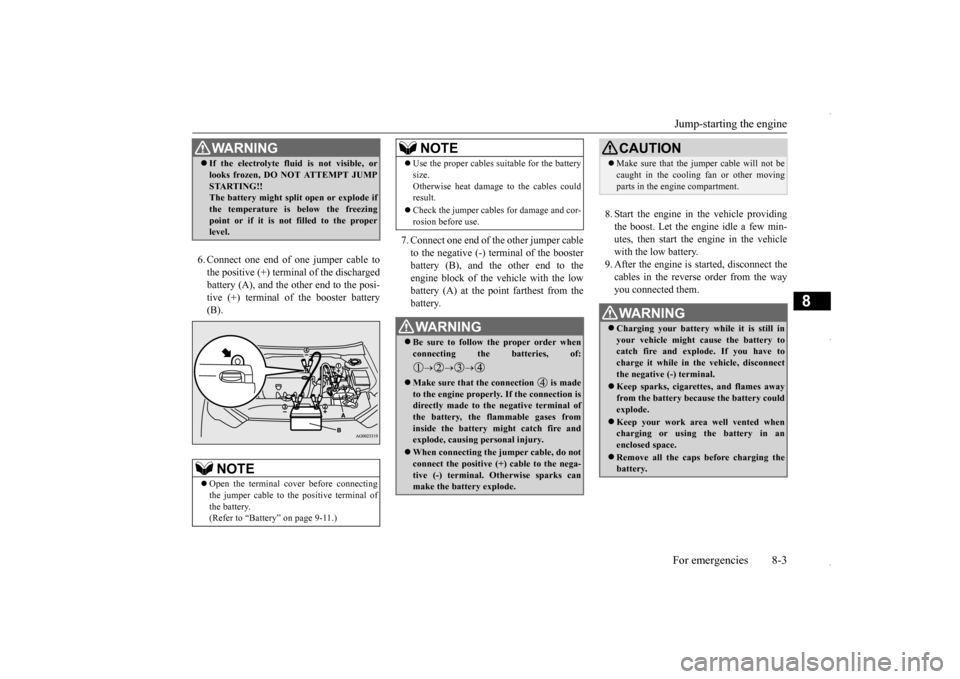
Jump-starting the engine For emergencies 8-3
8
6. Connect one end of one jumper cable to the positive (+) terminal of the discharged battery (A), and the other end to the posi- tive (+) terminal of the booster battery(B).
7. Connect one end of the other jumper cable to the negative (-) terminal of the boosterbattery (B), and the other end to the engine block of the vehicle with the low battery (A) at the point farthest from thebattery.
8. Start the engine in the vehicle providing the boost. Let the engine idle a few min-utes, then start the engine in the vehicle with the low battery. 9. After the engine is started, disconnect thecables in the reverse order from the wayyou connected them.
WA R N I N G If the electrolyte fluid is not visible, or looks frozen, DO NOT ATTEMPT JUMP STARTING!! The battery might split open or explode if the temperature is below the freezingpoint or if it is not filled to the proper level.NOTE
Open the terminal cover before connecting the jumper cable to the positive terminal of the battery.(Refer to “Battery” on page 9-11.)
Use the proper cables suitable for the battery size. Otherwise heat damage to the cables could result. Check the jumper cables for damage and cor- rosion before use.WA R N I N G Be sure to follow the proper order when connecting the batteries, of:
Make sure that the connection is made to the engine properly. If the connection isdirectly made to the negative terminal of the battery, the flammable gases from inside the battery might catch fire andexplode, causing personal injury. When connecting the jumper cable, do not connect the positive (+) cable to the nega- tive (-) terminal. Otherwise sparks can make the battery explode.NOTE
CAUTION Make sure that the jumper cable will not be caught in the cooling fan or other moving parts in the engine compartment.WA R N I N G Charging your battery while it is still in your vehicle might cause the battery to catch fire and explode. If you have tocharge it while in the vehicle, disconnect the negative (-) terminal. Keep sparks, cigarettes, and flames away from the battery because the battery could explode. Keep your work area well vented when charging or using the battery in anenclosed space. Remove all the caps before charging the battery.
BK0229600US.bo
ok 3 ページ 2015年10月1日 木曜日 午後2時29分
Page 324 of 398
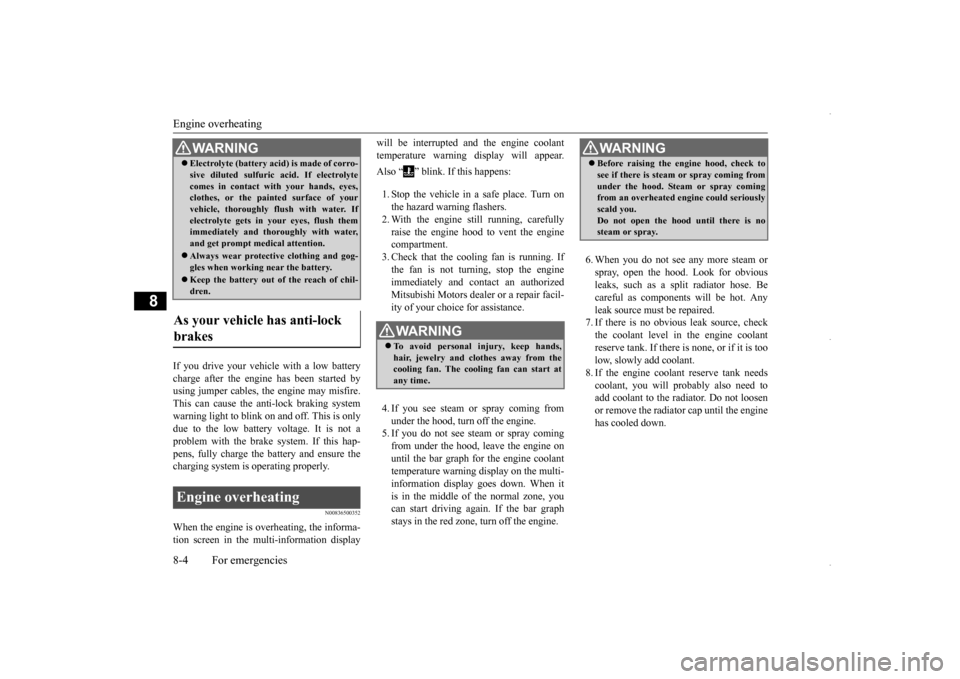
Engine overheating 8-4 For emergencies
8
If you drive your vehicle with a low battery charge after the engine has been started by using jumper cables, the engine may misfire. This can cause the anti-lock braking systemwarning light to blink on and off. This is only due to the low battery voltage. It is not a problem with the brake system. If this hap-pens, fully charge the battery and ensure the charging system is operating properly.
N00836500352
When the engine is overheating, the informa-tion screen in the multi-information display
will be interrupted and the engine coolant temperature warning display will appear. Also “ ” blink. If this happens: 1. Stop the vehicle in a safe place. Turn on the hazard warning flashers.2. With the engine still running, carefully raise the engine hood to vent the engine compartment.3. Check that the cooling fan is running. Ifthe fan is not turning, stop the engine immediately and contact an authorized Mitsubishi Motors dealer or a repair facil-ity of your choice for assistance. 4. If you see steam or spray coming from under the hood, turn off the engine. 5. If you do not see steam or spray comingfrom under the hood, leave the engine on until the bar graph for the engine coolant temperature warning display on the multi-information display goes down. When it is in the middle of the normal zone, you can start driving again. If the bar graphstays in the red zone, turn off the engine.
6. When you do not see any more steam or spray, open the hood. Look for obvious leaks, such as a split radiator hose. Be careful as components will be hot. Anyleak source must be repaired. 7. If there is no obvious leak source, check the coolant level in the engine coolantreserve tank. If there is none, or if it is too low, slowly add coolant. 8. If the engine coolant reserve tank needscoolant, you will probably also need to add coolant to the radiator. Do not loosen or remove the radiator cap until the enginehas cooled down.
Electrolyte (battery acid) is made of corro- sive diluted sulfuric acid. If electrolyte comes in contact with your hands, eyes, clothes, or the painted surface of your vehicle, thoroughly flush with water. Ifelectrolyte gets in your eyes, flush them immediately and thoroughly with water, and get prompt medical attention. Always wear protective clothing and gog- gles when working near the battery. Keep the battery out of the reach of chil- dren.
As your vehicle has anti-lock brakes Engine overheating
WA R N I N G
WA R N I N G To avoid personal injury, keep hands, hair, jewelry and clothes away from the cooling fan. The cooling fan can start atany time.
WA R N I N G Before raising the engine hood, check to see if there is steam or spray coming from under the hood. Steam or spray coming from an overheated engine could seriously scald you.Do not open the hood until there is no steam or spray.
BK0229600US.bo
ok 4 ページ 2015年10月1日 木曜日 午後2時29分
Page 347 of 398
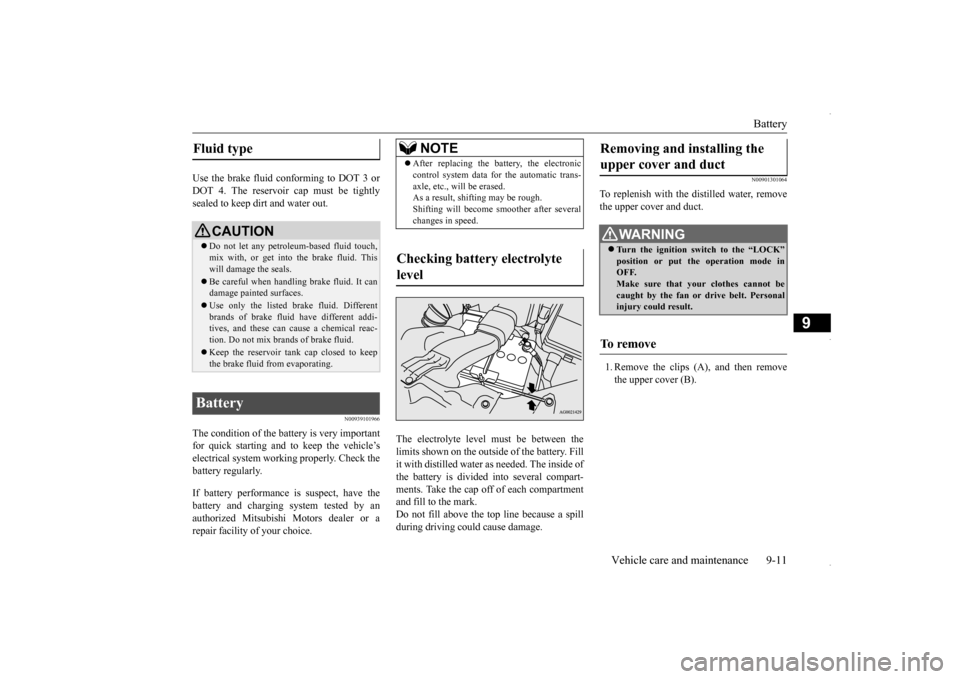
Battery
Vehicle care and maintenance 9-11
9
Use the brake fluid conforming to DOT 3 or DOT 4. The reservoir cap must be tightlysealed to keep dirt and water out.
N00939101966
The condition of the battery is very important for quick starting and to keep the vehicle’s electrical system working properly. Check thebattery regularly. If battery performance is suspect, have the battery and charging system tested by an authorized Mitsubishi Motors dealer or arepair facility of your choice.
The electrolyte level must be between the limits shown on the outside of the battery. Fill it with distilled water as needed. The inside of the battery is divided into several compart-ments. Take the cap off of each compartment and fill to the mark. Do not fill above the top line because a spillduring driving could cause damage.
N00901301064
To replenish with the distilled water, removethe upper cover and duct. 1. Remove the clips (A), and then remove the upper cover (B).
Fluid type
CAUTION Do not let any petroleum-based fluid touch, mix with, or get into
the brake fluid. This
will damage the seals. Be careful when handling brake fluid. It can damage painted surfaces. Use only the listed brake fluid. Different brands of brake fluid have different addi-tives, and these can cause a chemical reac- tion. Do not mix brands of brake fluid. Keep the reservoir tank cap closed to keep the brake fluid from evaporating.
Battery
NOTE
After replacing the battery, the electronic control system data for the automatic trans- axle, etc., will be erased. As a result, shifting may be rough. Shifting will become smoother after severalchanges in speed.
Checking battery electrolyte level
Removing and installing the upper cover and duct
WA R N I N G Turn the ignition switch to the “LOCK” position or put the operation mode in OFF.Make sure that your clothes cannot be caught by the fan or drive belt. Personal injury could result.
To remove
BK0229600US.bo
ok 11 ページ 2015年10月1日 木曜日 午後2時29分